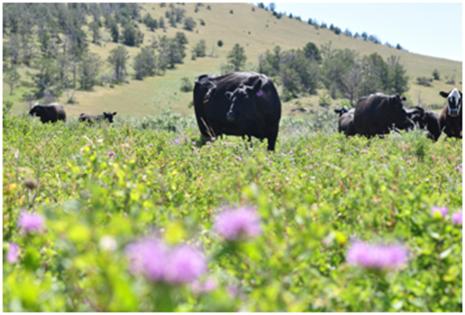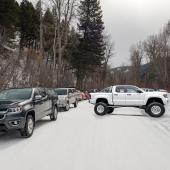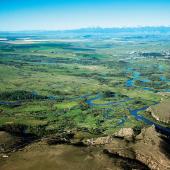Raising the Steaks
Stewardship at American Fork Ranch.
Seven of us pile into a van headed to the American Fork Ranch (AFR) and begin a conversation proctored by Bob Lee, owner of the Robert E. Lee Ranch in the beautiful Snowy Mountains. Lee won the Montana Stockgrower's Environmental Stewardship Award in 1997, and is a good friend of AFR's ranch manager. Among the contributing voices are Jesse Tufte, Northern Plains rep from the World Wildlife Fund, Jeff Mosley from Montana State University’s extension program, and Rusty Terland from the Crazy Mountain Stockgrower’s Association.
We rattle down long dirt roads, past winding unnamed streams; past the best middle-of-nowhere burger joint called Bill’s Place; past Porcupine Butte and the first Lutheran church in the state. Bob points out the old Hathaway place on our right as if it was a graveyard, mentioning how much of a challenge it can be for ranchers to keep ancestral land in the family, anymore. But about 115 miles northeast of Bozeman, in Sweetgrass County, there’s a sprawling ranch dotted with hundreds of cattle that has been in the Stevens family for five generations.
AFR proudly runs a successful cow-calf operation on their 26,000 acres. The summer air is thick with the musty smell of livestock, as ranch managers Jed and Annie Evjene stand in front of a sundry group of more than 40 gathered “tourists,” myself included, who have just been carted out to the remote property from our meeting place at the historic Grand Hotel in Big Timber. On this Tuesday morning, we’ve been invited to visit the American Fork Ranch as a part of their “Raising the Steaks” expo in honor of the ranch’s acceptance of the 2015 Environmental Stewardship Award from the Montana Stockgrower’s Association.
The MSA says the award is given in acknowledgement of ranchers “going the extra mile to preserve and enhance resources on their land, focusing on industry stewardship and ideas that can be extended to other operations.” The tour is lead by Jed, a large Montana man with a stocky frame and a bright smile, and he points out places on the ranch where they’re taking particular care to be good stewards of the land. He takes the group all over the property, talking fondly about soil quality and their careful records of management at the ranch. When we get up close to his cattle for the first time, their fat, black frames shiny under the hot sun, Bob turns around, absolutely delighted, and reveals a carnival smile as he laughs. “Some guys like alcohol, some guys like drugs; I like black heifer cows.”
Besides obvious management methods, such as diligent cattle-rotation to avoid overgrazing and overuse of pasturelands, the cows at the American Fork are moved every seven days by a single cowboy. Jed and Annie have gotten inventive — they put in interior cross-fencing to help break up big pasture sections and disperse grazing for more even wear on the soil and grasses. Upland water sources lessen the herd’s impact on the creeks and streambeds, and four intact beaver dams on the ranch help preserve riparian areas.
Jed notes that every pasture has at least two water sources as opposed to the usual allotment of one, and the pastures themselves have quite creative names for a poignant reason. “We named the pastures after the grandkids, hoping that it might make them have some accountability,” Jed tells the group. “You name a pasture after them and you better bet that they’re gonna know how many water sources are in their pasture.”
The ranch troughs have a cool new design, too. Traditional troughs run the risk of birds and smaller ground animals falling in and drowning, and young calves tend to get pushed out by the hierarchy of the herd. Jed’s troughs, filled from a gravity stock tank that pulls from the creek, are metal and allow for little critters to use the side wiring to climb back out. The length and height of the trough evens the playing field for smaller calves by giving them bunk space, and each tank is on a fenceline so it can be utilized in more than one pasture. The ranch has wildlife on its mind for fences, too, positioning them 18 inches off the ground with large spaces between the rails so antelope and deer can safely negotiate fences or free caught limbs while crossing the property.
AFR also allows some private hunting to help manage wildlife populations and keep certain flora from being destroyed, like cottonwoods. Since Sweetgrass County is situated on one of the world’s four remaining grasslands, Jed and the Stevens family work with the WWF’s northern grasslands liaison, Jesse Tufte, to brainstorm ways to keep ranching communities resilient, both financially and environmentally.
The day wrapped up after a lunchtime demonstration from Texas chef Mike Erickson, who focused on how to cut steaks and how to prepare them. We were all asked what stewardship meant to us, and the rhetoric thrown around could have come from an environmental science textbook. We discussed balance, pastoralism, public grazing and carbon sequestration, the safety and efficiency of a cattle operation, and the resiliency of delicate landscapes and ecosystems. The conversation didn’t leave out the hard questions, like how do we provide more food, on less land, at a lower cost, while decreasing our environmental impact. With many truly thoughtful responses to an impossible question, it was Jeff Mosley from MSU who reminded us: “Stewardship is about land ethics. Whatever is good for the land is what’s right; but remember that stewardship accounts for people, too. It might sound corny, but this is about having a collaborative love for the land.”













